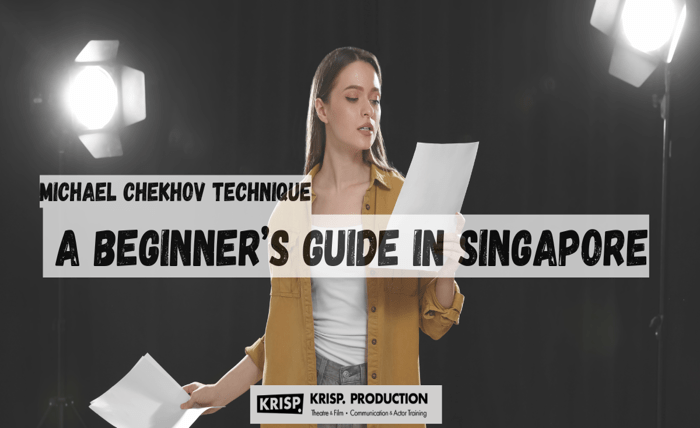Why do some actors captivate audiences while others just recite lines? The answer often comes down to the Michael Chekhov Technique.
Though most people think you need years of formal training to learn advanced acting methods, that’s simply not true. And we’re about to reveal how you can start today.
After years of teaching in acting workshops, we notice the same thing every time. While actors who learn Chekhov’s method discover emotional depths, performers who rely on basic techniques often struggle with wooden performances and one-dimensional characters.
That’s exactly why we at Krisp Production specialize in making this transformative technique accessible to beginners through our hands-on Singapore workshops.
Here’s what we’ll explore together:
- The core concepts behind Chekhov’s method
- Physical exercises you can try right away
- Finding quality training programs in Singapore
- Your competitive advantage with this technique
Come along as we explore the acting method that’s helped countless performers find their true artistic voice.
Michael Chekhov Technique in Singapore: The Core Concepts
For decades, the Michael Chekhov technique has changed how actors create characters and show real emotions. This method uses body movements and creative thinking to help performers find honest emotional connections with their roles.

Here’s what makes this technique work so well for actors at every level:
What is the Michael Chekhov Technique?
The Michael Chekhov technique is an acting method that Russian actor Michael Chekhov created in the early 1900s.
Instead of using personal memories, this method helps actors use their imagination and body to understand a character’s inner life. It’s like having a bridge between what you feel inside and what the audience sees.
Here are ways body movements show what’s inside a character:
- Tight fists (express strong will or hidden anger)
- Open hands (show trust or feeling exposed)
- Sharp shoulder moves (reveal stress or fear)
The reason these body movements work is simple: they open doors to feelings. When you use this technique, movement and imagination team up to create characters people believe.
Chekhov vs Stanislavski: A Quick Comparison
Both Chekhov and Stanislavski were Russian teachers who gave actors new ways to perform. But there are some differences between their methods. And the main difference between Chekhov and Stanislavski comes down to how actors find emotions.
One great example of this difference is how each method approaches sadness. While Stanislavski asks you to remember your own sad times, Chekhov teaches you to feel how sadness moves through your body. So you work from the outside in rather than the inside out.
We recommend the Michael Chekhov technique for beginners because it gives you physical tools like gestures and movements you can use right away. You don’t have to dig into painful personal memories or spend years studying complex theories.
Now that you know the basic differences between these techniques, let’s explore how to apply Chekhov’s method specifically to film and theatre work in Singapore.
Applying Chekhov to Film and Theatre in Singapore
How do you take what you’ve learned about the Chekhov method and make it work in productions? Well, you can start by using easy physical gestures in your next audition or rehearsal, then build up to more complex character work as you get comfortable with the basics.
Let’s explore how this method fits into Singapore’s acting scene:
How Michael Chekhov’s Method Benefits Local Actors
If you’re a local actor from Singapore, Chekhov’s techniques help you to develop characters faster and connect with emotions more easily during busy production schedules. This technique works through quick physical warm-ups that prep your body and mind before scenes, so you can jump into character without long emotional preparation.
Useful Tip: Practice one gesture each day, like how your character walks or holds their hands. Then use that same movement during auditions to help you stay in character even when you feel nervous.
Psycho-Physical Exercises for the Stage and Screen
Once you understand how gestures connect to emotions, you can start using psycho-physical exercises. These are movements that help you find your character’s feelings through your body.
Here are some basic exercises you can try right away:
- Walk like how your character feels (heavy or light)
- Practice hand gestures that show confidence or fear
- Move your shoulders to express different moods
The best part about these exercises is how easily they move from stage to screen. When you use imagination and body awareness to find your character’s intentions in any scenes, it becomes natural and honest.
Also, you can use these performance techniques in both theatre work and film training because they give actors tools that work on stage and screen. All you have to do is practice these exercises regularly so they become easy and natural in your performances.
Since you now understand how this method works in Singapore’s acting scene, the training becomes the next step for developing your skills.
How to Train with the Chekhov Technique to Build Acting Skills
You can start training with the Michael Chekhov technique by finding quality classes, practicing daily exercises, and working with experienced teachers who understand this method.

The best approach combines structured learning with hands-on practice, so you get both theory and real acting experience. What’s even better is that most actors see improvements in their emotional range and character work within just a few weeks of consistent training.
Here are the major areas to focus on when you start your training:
Finding the Right Chekhov Class in Singapore
Can you find quality Chekhov training that fits your needs and budget? Yes, you can, but it takes some research to find programs that teach the method properly.
Before you sign up anywhere, remember to look for arts schools or studios where students work directly with the techniques during each class. It’s better to choose a hands-on program than one that only talks about theory.
The best programs offer flexible schedule options, so you can take a weekend course or commit to full-time study based on your availability.
Pro Tip: When looking for acting programs, find a class led by an experienced teacher who can show you how it applies to performing arts work. You won’t get the same results from someone who just reads about it from books.
How Chekhov Technique Can Set You Apart
The Chekhov technique can set you apart from others because most actors still rely on basic emotion memory methods. But if you can create deeper character development, you’ll have an edge during auditions and performances.
When an artistic director watches you work, they’ll notice how naturally you move between different emotions and character states. Also, your film and theatre productions will benefit because you spend less time preparing for each scene.
That’s what separates good actors from great ones. And frankly, it’s much more fun than digging up sad memories every time you need to cry.
Build Stronger Characters Using Body and Imagination
Many new actors feel lost when trying to create believable characters using old memory-based methods that feel forced. But with Chekhov’s technique, you can build performances through body movements and imagination.
In this article, we’ve covered the main ideas behind Michael Chekhov’s acting method and how it works differently from other ways of acting. You’ve also learned easy ways to use these techniques in Singapore’s theatre and film world.
When you’re ready to change your acting through this powerful technique, we’ll be happy to help you take that next step forward.



